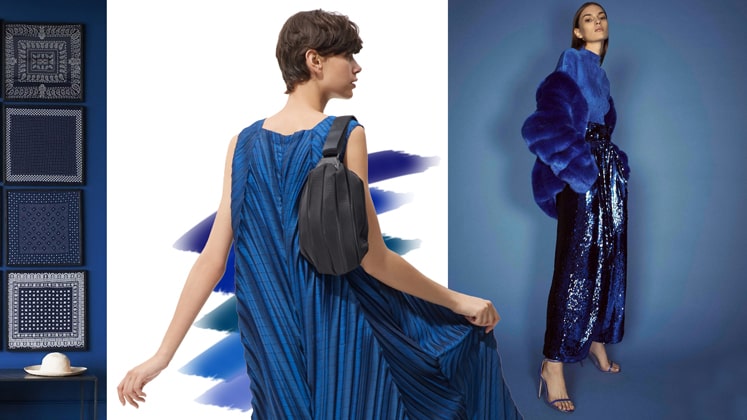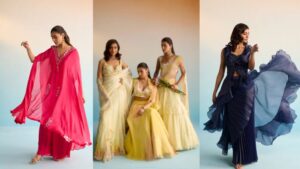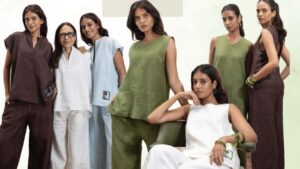Every part of the world in one form or the other has embraced Indigo, and all this started with the Dulux global tradition, Chemical and Allied Products (CAP) Plc, unveiling ‘Indigo Night’ as the colour of the year, based on the deliberation of a group of international creative experts from the fields of colour, design, architecture and fashion. Lending itself to every aspect of living both inside and out, indigo looks stunning on walls as it does in furniture and accessories, elaborating on which Larry Ettah, Group Managing Director, UACN Plc says, “The colour has an intriguing connection with the past, the present and future. The colour shade has always been part of our lives and will continue to play a major role in our existence as it is indeed, a colour of our heritage and the future.”
Having a traditional presence in the Japanese culture, amongst a variety of techniques, there is Boro, a well known, patched indigo usually found in sheeting like sizes offering a kaleidoscope of indigo dyes put together, along with another tie&dye textile technique, Shibori. Worn by Japanese firemen as heavy quilt and woven indigo-dyed jackets and helmet hats, since decades owing to its property of not burning out, the indigo colour has been used since time immemorial in designing Kimonos.
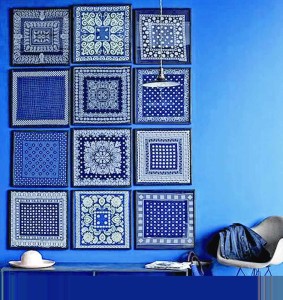 The dawn of this trend has also brought to the forefront the graphic traditional Japanese patterns, which have made a comeback into the fashion scene with designer names like Band of Outsiders showcasing the Japanese dyeing technique in their S/S 2013 collection. Creating a refreshing array of tailored blazers, shorts, and sharp wrap skirts, some of the looks even took on a cool, denim-like effect. Spreading into kidswear too, Le Petit Lucas du Tertre, a French brand for kids in its recent summer 2013 range used Japanese influenced patterns in bright shades of indigo, for children’s fashion. Other known names that have started to showcase the same on the runways of S/S 2014 are of Vivienne Westwood presenting jacquard boro surfaces in sporty indigo pieces and Etro a range of Indigo-on-indigo print and patterns. Also available with fast fashion retailers are variations of Shibori techniques in pieces like tank tops at All Saints, and Scarves at Zara.
The dawn of this trend has also brought to the forefront the graphic traditional Japanese patterns, which have made a comeback into the fashion scene with designer names like Band of Outsiders showcasing the Japanese dyeing technique in their S/S 2013 collection. Creating a refreshing array of tailored blazers, shorts, and sharp wrap skirts, some of the looks even took on a cool, denim-like effect. Spreading into kidswear too, Le Petit Lucas du Tertre, a French brand for kids in its recent summer 2013 range used Japanese influenced patterns in bright shades of indigo, for children’s fashion. Other known names that have started to showcase the same on the runways of S/S 2014 are of Vivienne Westwood presenting jacquard boro surfaces in sporty indigo pieces and Etro a range of Indigo-on-indigo print and patterns. Also available with fast fashion retailers are variations of Shibori techniques in pieces like tank tops at All Saints, and Scarves at Zara.
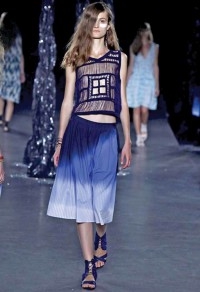
Parallel to its history in Japan, moving onto the Indian subcontinent, till date India is recognized as the most primitive place for the indigo dye, as it was first in the sixteenth century that the cultivation of indigo started in India on a large scale, which through the established Dutch trade routes by sea, made its way to Europe. Mesmerizing them yet again, bringing them back to India for sourcing the trend for the next S/S14 developments and already receiving orders, Vikas Chachra, Head of Sales, India 1 of Clariant Chemicals (India) Ltd. claims, “The demand for Indigo is increasing at a fast rate as the shade, properties and its wash downs cannot be matched by any other class of dyes. Indigo as a colour has been around for more than 100 years and in the fashion industry for more than 20 years, which is a legacy difficult to break.
In some cases the sale has more than doubled. Although as Indigo is blue, the industry is now moving beyond, also asking for other casts of blues with wash down properties for which Clariant provides an exclusive range known as DIRESUL RDT.”
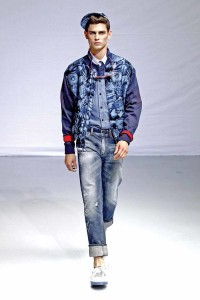
Nitish Vikram, Senior Designer, Bhane Designs adds, “Indigo is a classic colour – and the dye is good for the skin and also gives a character to the garment. The beauty of an indigo dyed garment is the fact that it loses colour every time it is washed, so one is almost wearing a different garment every time. Being an eco-friendly dye it has once again started to work well in the Indian market as well as international market.” Working with denim, chambray and viscose fabric in techniques like tie & bleach, over bleach, heavy enzyme wash & discharge printing, for the current collection of the online youth brand, Bhane; in contrast he also states that as the natural dye pigment cannot be easily procured, so it is a bit difficult to work with it too, as compared to other chemical dyes.
Supporting the thought of the challenges one faces while using the colour, Pramod Rathore of Indus Valley Exports says, “In our experience the Indigo colour is very uncertain to work with as it tends to fade and hence buyers are skeptical to work with it. Since the dyeing has to be outsourced, we would always find the washing or the printing lacking it in its consistency. We used to work heavily with the dye earlier but since it was difficult to keep up with buyer’s quality requirements, we quit working with the dye one-and-a-half years back.”
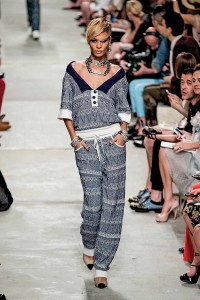
In the world of fashion the colour indigo is more closely associated with denim. Considering that approximately 20 million tonnes of indigo are produced annually for the purpose, with the up rise of the colour blue, Denim is another form of indigo that has come back into fashion. Authenticating this growing demand, the S/S 2014 and Cruise 2014 runways had an explosion of denim in the collections of Diesel Black Gold, Frankie Morello, Andrea Incontri, Chanel, Givenchy, Theyskens’ Theory and Jonathan Simkhai.
Facing happy consequences of the same, Aditi Talwar, Assistant Merchandiser of Orient Craft confirms, “Our denim division is getting huge orders for jeans, shirts and shorts in denim from the US buyers. Different varieties of denim are being worked onto garments in fabrics like chambray, tencel, lightweight and heavyweight variations. Light & dark wash, ice wash, tie&dye and different kinds of bleach treatments are part of the developments too. Demand for boyfriend shirts in light indigo has been immense from buyers as well.”
Indigo as a solid hue itself has a long list of symbolic connotations that are global, considered as a royal colour associated with nobility, political power and other blue bloods. From a favourite of the couture market and formal evening wear in the jewel tone of sapphire for womenswear, the colour blue which has long been synonymous with menswear staples as well, took a traditional indigo turn in the recent collections of Armani, Bottega Veneta, Hermes and Versace.
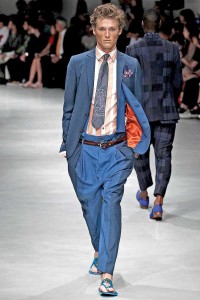
Following the trail, exporters for S/S 2014, are getting orders for styles in the indigo colour for ready-to-wear productions as well, as Dheeraj Chauhan, PD Merchandiser, Dhruv Global, claims, “Indigo for us has been a common colour in every style since pre-spring orders. We’re dyeing polo and crew necks in vintage indigo for our buyers in the US as a part of Spring/Summer developments. The single dye is being done on cotton poly fabric and we are also doing light acid and garment enzyme wash on jersey fabrics as well.”
Still to make a mark in the Indian market which can still be considered debatable as a concept, Deepu Nair, Senior Textile Designer of SRG Fabs claims, “The colour Indigo is not very easily accepted by the Indian market as consumers are still divided between dusty shades and a brighter colour palette. the international market prefers the colour as they value the process behind it.”

